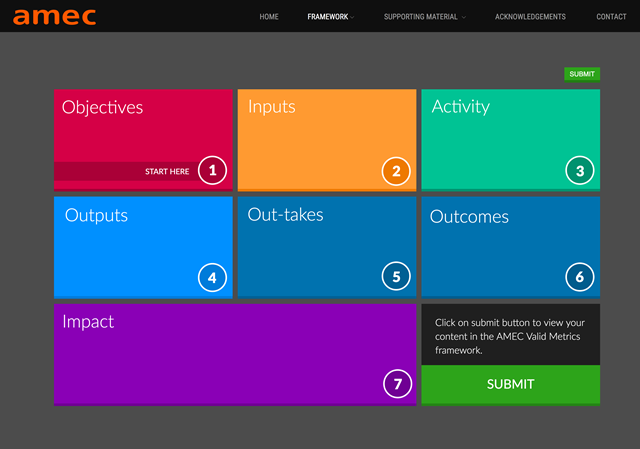
Image credit: AMEC
PR measurement experts call AMEC’s new Integrated Evaluation Framework the hottest thing in measurement — a new tool that may raise PR to a new level of respect. They also point out its limitations.
The framework, an interactive version of the original framework, uses digital technology to guide PR pros through a step-by-stop process to plan and implement an effective program of PR evaluation and measurement. The framework “operationalises” and shows how to implement Barcelona Principles 2.0, explains AMEC, an international association for communications measurement.
It links organizational objectives to communications objectives to outcomes and organizational impact, and measures across all PESO (Paid, earned, shared, owned) channels. AMEC says the framework received “instant acclaim” from the PR industry when launched at its International Summit in London last month.
“We wanted to take the pain out of measuring communication in what has become an ever more complex world,” said Richard Bagnall, CEO of Prime Research UK and an AMEC board director. “This interactive tool allows organizations of all sizes to easily plan and measure their integrated communications activity, proving the value of their work in a meaningful and credible manner.”
The Visual Improvement of Multi-Colored Squares
The tool presents seven mulita-colored squares where PR pros enter information about their campaign. Visually, it’s an enormous improvement over the old framework. However, providing the necessary information remains just as challenging, writes Katie Paine, CEO of Paine Publishing in a blog post. The AMEC creators enjoy high levels of measurement expertise and work at large organizations. Most PR is for less sophisticated small to medium-sized businesses, restaurants, NGOs and government agencies.
“Ultimately, I love this framework, not because it is perfect, or even particularly easy to use, but because it poses the kind of questions that I’ve been answering for thirty years,” Paine says.
Before using the tool, do your homework, Paine advises. Thoroughly research your organization’s goals and how PR contributes to success.
“For agency folks, this [measurement] is your biggest weakness and one reason why PR gets no respect when budgets get tight,” Paine warns. “If you don’t have an agreed-upon definition of how PR contributes to the success of the organization, then you’ll never get past square one (literally).”
Understand the Framework’s Limits
Michael Blowers at Media Evaluation Research says the framework has limitations:
- It doesn’t “evaluate” your coverage for you. Consider it a checklist — a series of questions and suggestions.
- Not all suggestions and stages are relevant to every campaign. Many can be ignored. Because campaigns are unique, no framework can precisely fit your needs.
- It doesn’t save your work. Because of copyright/data protection reasons, you can’t save your session and return to it on another day, you can print it as a PDF. (Alternatively, you can enter the information into a Word document or have your technology folks set up an interactive form that mimics the framework – and maybe modifies it to meet your specific needs.)
- It doesn’t provide a score to make comparisons.
“Once you are well familiar with the stages and options you might find you can live without the framework,” Blowers says. “It is really an education tool. It is an interactive instructional mechanism which lays out in one place a structured approach common to all evaluation processes. It explains some of the terminology and what kind of metrics, options and connections which could be relevant to prove an effect.”
Bottom Line: AMEC’s new evaluation framework represents a major step in the PR industry’s effort to improve measurement and gain greater respect in the corporate world. While the interactive tool may help improve PR measurement, it is not a panacea for all of PR’s measurement challenges.
William J. Comcowich founded and served as CEO of CyberAlert LLC, the predecessor of Glean.info. He is currently serving as Interim CEO and member of the Board of Directors. Glean.info provides customized media monitoring, media measurement and analytics solutions across all types of traditional and social media.




